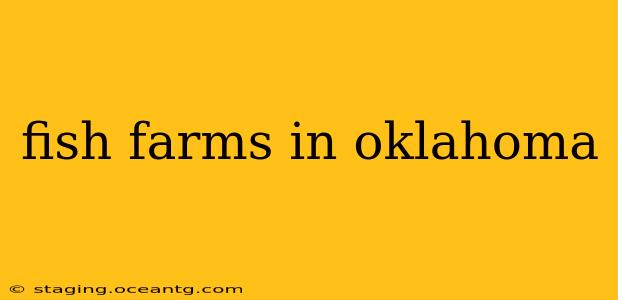Oklahoma, known for its vast plains and rich agricultural heritage, also boasts a growing aquaculture industry. While not as prominent as some coastal states, Oklahoma's fish farms contribute significantly to the local economy and provide fresh, locally sourced seafood. This comprehensive guide explores the landscape of fish farming in Oklahoma, addressing common questions and providing insights into this fascinating sector.
What types of fish are farmed in Oklahoma?
Oklahoma fish farms primarily focus on species well-suited to the state's climate and water resources. Channel catfish are by far the most common, known for their hardy nature and relatively fast growth rate. Other species you might find include tilapia, which thrive in warmer waters, and trout, often raised in colder, controlled environments. Some farms may also experiment with other species, but catfish remains the dominant player in Oklahoma's aquaculture scene.
How many fish farms are there in Oklahoma?
Precise figures on the exact number of fish farms in Oklahoma fluctuate. The Oklahoma Department of Agriculture, Food, and Forestry provides some data, but a definitive, publicly available count is difficult to pinpoint. The number of operations varies, with some being small-scale family operations, and others larger commercial enterprises. The industry is dynamic, with new farms emerging and others potentially consolidating or closing. To obtain the most current information, contacting the Oklahoma Department of Agriculture, Food, and Forestry directly would be advisable.
Where are the fish farms located in Oklahoma?
Oklahoma's fish farms are scattered across the state, often near suitable water sources. While there isn't a concentrated "fish farming region," you'll find them in various locations, often leveraging existing infrastructure like ponds or reservoirs. The specific locations are not always publicly accessible due to business confidentiality, but proximity to water sources is a key factor in their placement.
What are the environmental impacts of fish farms in Oklahoma?
As with any form of aquaculture, Oklahoma's fish farms face environmental considerations. Potential impacts include water quality issues stemming from fish waste and uneaten feed. Responsible farming practices, including proper waste management and responsible feeding strategies, are crucial to mitigating these effects. Regulations and best practices are continuously evolving to minimize the environmental footprint of aquaculture operations.
Is it legal to have a fish farm in Oklahoma?
Yes, it is legal to have a fish farm in Oklahoma, provided it adheres to state and federal regulations. These regulations cover aspects such as water quality, waste disposal, and the permitted species. Before establishing a fish farm, prospective operators must navigate the necessary licensing and permitting processes through the appropriate state agencies. The Oklahoma Department of Agriculture, Food, and Forestry is the primary agency to contact for details regarding licensing and regulations.
What is the future of fish farming in Oklahoma?
The future of fish farming in Oklahoma is promising. Growing consumer demand for locally sourced food, coupled with advancements in aquaculture technologies, presents opportunities for expansion and innovation. Research into sustainable aquaculture practices and the development of new species suitable for Oklahoma's climate are likely to shape the industry's trajectory in the coming years. The industry's success will hinge on sustainable practices and a balance between economic growth and environmental stewardship.
Conclusion:
Oklahoma's fish farming industry, while relatively understated, plays a vital role in the state's economy and food security. The future growth and sustainability of this sector depend on responsible practices, regulatory compliance, and continuous innovation. For those interested in learning more, the Oklahoma Department of Agriculture, Food, and Forestry serves as a valuable resource for up-to-date information and support for the aquaculture community.
